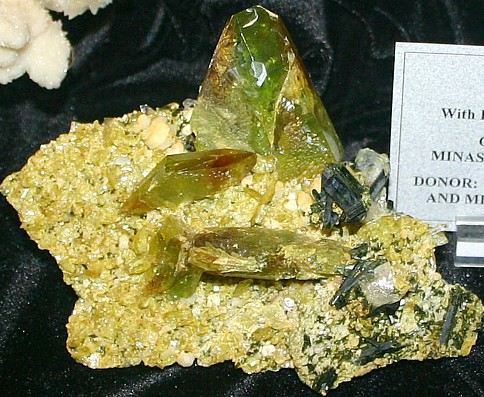|
.
Sphene Mineral Facts:
Chemical
Formula: CaTiSiO5
Sometimes known as Titanite.
Colors:
Brown, black, gray, green, yellowish, sometimes
rose pink or white.
Its streak is white or pink.
Hardness:
5 to 5.5
Hardness varies somewhat depending
on formation and impurities.
Density: 3.4
to 3.55
Cleavage:
Prismatic cleavage {110} distinct; a parting on {100} may also be
present.
Crystallography: Monoclinic
Crystals varied in habit. Often with prominent basal plane which is steeply inclined and which
in combination with short prism and pyramid faces a thin wedge-shaped
crystal.
Both contact and penetration
twins are common.
Luster:.
Vitreous or resinous
and it is transparent, translucent or opaque.
Optics:
(Refractive Index) a = 1.90; b = 1.907; y = 2.034
Its refractive indices vary widely with the composition. In a specimen
from St. Gothard,
the indices for yellow light were: a= 1.874, B= 1.8940, y=
2.0093. It is pleochroic in yellow, pinkish and nearly colorless tints.
|
 |
Composition,
Structure and Associated Minerals:
Sphene is a widely spread
constituent of igneous rocks where it has probably formed directly by
crystallization from a molten magma, and is found in many schists and
limestones that have been metamorphosed. In the latter cases it is of
metasomatic origin. Calcium titano-silicate, Sphene consists of
Silica 30.6%, titanium oxide
40.8%, lime 28.6%. Iron is usually present in small amounts.
Titanite, or sphene, usually occurs as
crystals, but in some places in granular, compact masses and
lamellar forms. Many
specimens show also the presence of Fe2O3
, A12O3
, and in some cases considerable
quantities of Y2O3
.
Identification and Diagnostics
Fusible at 4 with
slight intumescence to a dark glassy mass. Only slightly attacked by
hydrochloric acid. Fused with sodium carbonate; fusion product can be dissolved in
hydrochloric acid; the solution when boiled with tin gives a violet
color (titanium).
With beads some varieties exhibit the
reaction for manganese and all show the colors characteristic of titanium.
All varieties are sufficiently soluble in HC1 to give the violet colored
solution when treated with tin, and all are completely decomposed by H2SO4. Sphene is
distinguished from staurolite and garnet by its crystallization and
softness; from sphalerite by its greater hardness; from other similarly
colored minerals by the reaction for the presence of titanium.
Occurrence,
Localities and Origins:
It
occurs as a minor mineral in many metamorphic and acidic intrusive rocks,
under which conditions it forms during cooling. Further, it is a common
decomposition product of ilmenite and rutile.A
rather common accessory mineral in igneous rocks, being found as small
crystals in granites, diorites, syenites, trachytes, phonolites, etc. Also
found often in crystals of considerable size embedded in the metamorphic
rocks, gneiss, chlorite-schist and crystalline limestone. Very commonly
associated with chlorite. Also found with iron ores,
pyroxene, amphibole, scapolite, zircon, apatite, feldspar, quartz, etc.
Localities. The mineral occurs so
widely spread that even its principal localities are too numerous to mention
here. Particularly fine crystals are found at Ala and St. Marcel, in
Piedmont; at various points in the Zillerthal, Tyrol; Tavetsch, St. Gothard,
etc., Switzerland; Ala, Piedmont; at Zoptau,
in Moravia; near Tavistock and Tremadoc, in Wales; at Sandford, Maine; at
various points in Lewis, St. Lawrence and Orange Counties,
New
York, principally in
limestones; at Franklin Furnace,
New
Jersey, also in limestone; in Iredell, Buncombe and Alexander Counties,
North Carolina, and near Eganville, Renfrew County, Ontario.
Fine crystal specimens, some of gem quality,
come from Mexico and Brazil. The name Sphene comes from a Greek
word meaning wedge - in allusion to a characteristic development of the
crystals.
Uses: Sphene is mined on the Kola Peninsula in
Russia as an ore of Titanium. In some cases when the mineral is sufficiently
transparent, sphene has been cut as a gemstone. For More information about
Sphene as a gemstone, see
Sphene - An Extraordinary Bright Gem
Return to the
Mineral Collectors Information Page |
|


